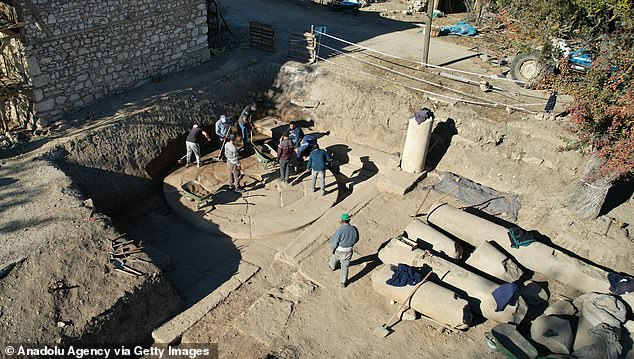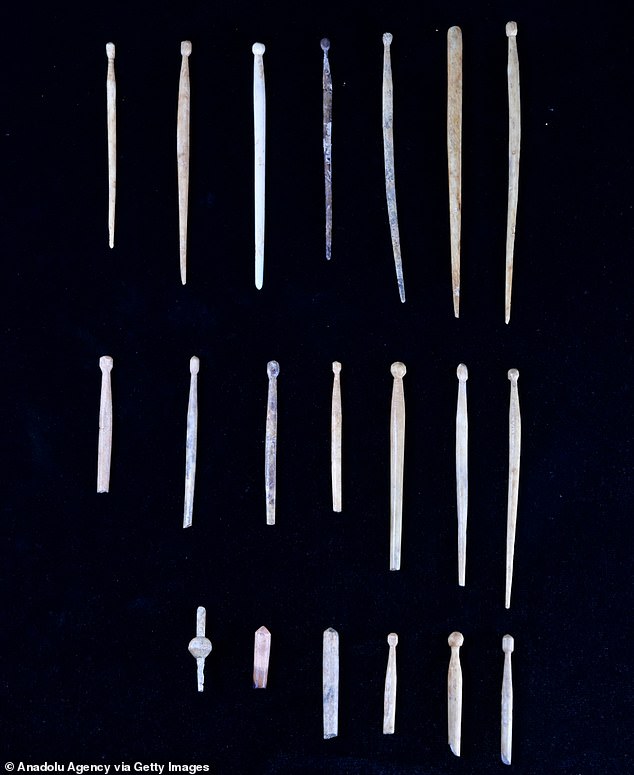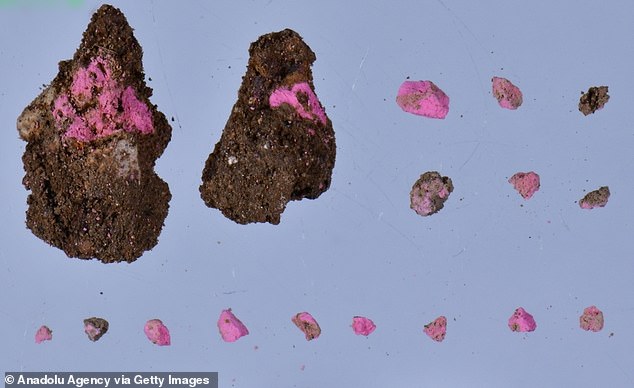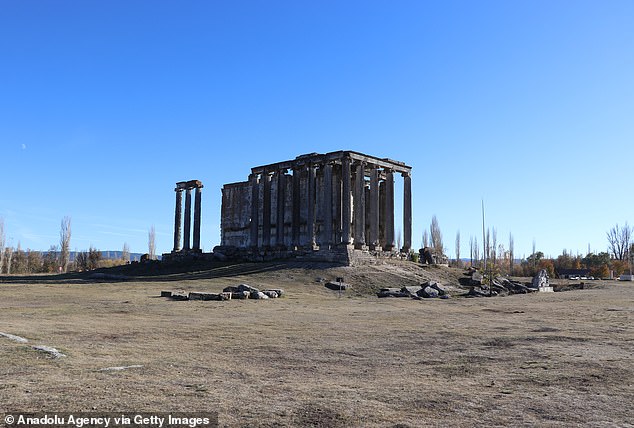Archeologists unearth 2,000-year-old ancient Roman makeup in Turkey that is similar to blush and eyeshadow used today – and it is still intact
Archaeologists in Turkey have unearthed cosmetics and jewelry dating back thousands of years – and some items are still intact.
The find was discovered in the remains of a 2,000-year-old marketplace east of the well-preserved Temple of Zeus in Anatolia, a site where intensive excavations have taken place since its rediscovery in 1998.
The archaeologists discovered ten different shades of ancient Roman makeup pigments, mainly shades of red and pink, but also jewelry, perfume bottles and other cosmetic antiques.
The excavation’s lead archaeologist, Professor Gökhan Coşkun of Dumlupinar University, said the ancient Roman makeup is “similar to the blush and eye shadow used today.”
But the makeup was just one product offered in what Coşkun believes was a special cosmetics store in this classical period agora (marketplace).
Archaeologists in Turkey have unearthed cosmetics and jewelry dating back thousands of years in the remains of a 2,000-year-old marketplace east of the Temple of Zeus in Anatolia. The find contains 10 different shades of ancient Roman makeup pigment, mainly shades of red and pink

Items discovered also included jewelry, perfume bottles and other cosmetic antiques. Above, archaeologists excavate a fountain-like Roman structure at the same ancient excavation site

The ancient beauty salon, which the archaeologists said was now ‘completely exposed’, contained ‘several beads belonging to products such as hairpins and necklaces’ (above)
“During the excavation here we came across a large number of perfume bottles,” Coşkun said.
‘There is also jewelry.’
If he told the state-run Turkish News Agency Anadolu AjansiThe jewelry contained “various beads belonging to products such as hairpins and necklaces used by women” at the store, which he described as now ‘completely exposed.’
Although Coşkun noted that not all finds were in a “very well-preserved condition,” and that some were merely fragments “found in pieces of 1 or 2 millimeters (0.04 in),” some would still be in good condition today can yield a price.
“During the excavation we also found well-preserved pieces,” Coşkun said.
Coşkun, also a professor of classical archeology at the university, told the news agency that in Greco-Roman times, makeup, including eye shadow and blush, was often kept in oyster shells, as an organic and Mediterranean compact.
“We also came across a large number of oyster shells in the shop we excavated,” says the archaeologist.

The site’s chief archaeologist, Gökhan Coşkun, chairman of classical archeology at Dumlupinar University, told reporters that during Greco-Roman times, makeup, including eye shadow and blush, was often preserved in oyster shells (above), as an organic, Mediterranean compact.

Although Coşkun noted that not all finds were in a “very well-preserved condition,” and that some were merely fragments “found in pieces of 1 or 2 millimeters (0.04 in),” some would still be in good condition today can yield a price. Coşkun said that some “well-preserved pieces” were found during the excavation
Turkish archaeologists have been carefully working on the ancient site since 2011, taking over from the German Archaeological Institute, whose own 1970 work uncovered a theater, five bridges and two public baths.
In 2012, a Turkish delegation to the United Nations nominated the Temple of Zeus – and the entire surrounding ancient city of Aizanoi – for the Tentative List of UNESCO World Heritage Sites for consideration as a preserved historic site.
“This is a very important city in terms of religion,” archaeologist Görkem Kökdemir of Ankara University told Anadolu Ajansı news agency.
“We can call it the city of ‘gods and goddesses’.”

In 2012, a Turkish delegation to the UN nominated the Temple of Zeus (above) and the surrounding ancient city of Aizanoi on UNESCO’s Tentative World Heritage List to be considered a preserved historical site. The site was first rediscovered in 1824 and then lost again

The city was conquered by the Romans in 133 BCE and is said to have reached its true heyday in the second and third centuries AD. Above, an ‘acroterion’, or architectural ornament, for the Temple of Zeus. Archaeologists call Aizanoi ‘the city of ‘gods and goddesses’
“This has been evident from the work carried out so far,” Kökdemir told the news service, speaking about the discovery of the gateway to the Temple of Zeus in September 2021.
“Special shrines have been built here for many gods and goddesses,” he said.
The ancient city of Aizanoi’s Temple of Zeus, located about 56 kilometers from the modern city center of Kutahya, was first rediscovered in 1824 by European travelers and then partially excavated in the early 1890s by German archaeologist Karl Humann.
But the entire ancient metropolis was soon abandoned and lost again for decades.
Modern excavations at the site suggest multiple levels of settlement dating back to 3000 BC, including the 2,300-year-old Temple of Zeus in what was previously the Greek city of Magnesia.
The city was conquered by the Roman Empire in 133 BCE and is said to have reached its true heyday in the second and third centuries AD.
Although Turkish archaeologists have not previously found many Classic period beauty projects at the site, they have identified several locations that Roman citizens might have wanted to see.: a stadium, a commercial building, several necropolises and ‘the sacred cave of Meter Steune.’
Anadolu Ajansı describes the cave as “a cultist site probably used before the first century BC.”
“In ancient cities, people do not worship just one deity, but several gods or goddesses,” says Kökdemir.
‘In Magnesia the first deity is Artemis, and the second deity is Zeus.
“It’s very important, it’s the second important cult (of Magnesia).”
As of 2021, the leadership of the excavation project has reportedly been transferred to the authority of the Kutahya Museum Directorate.
